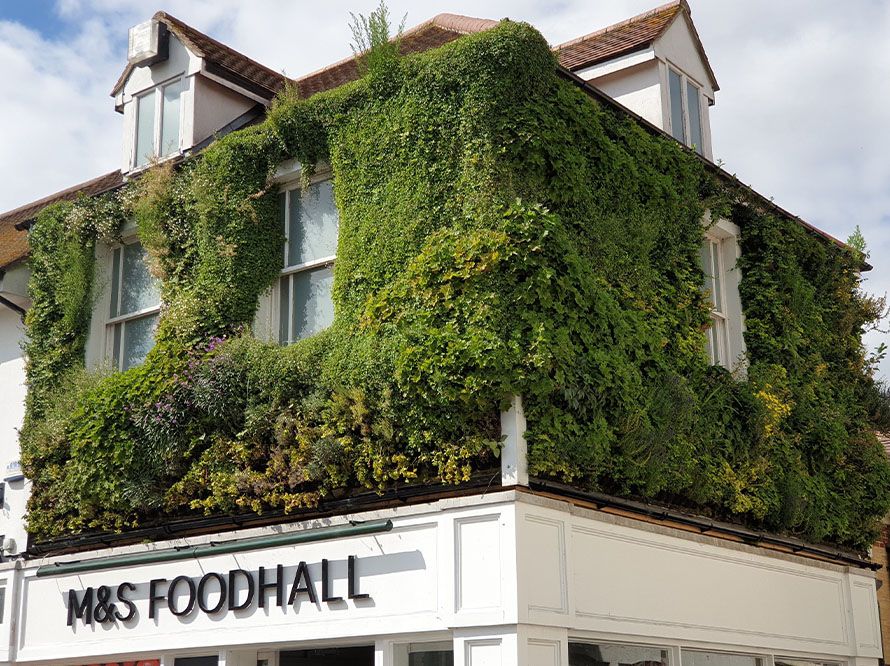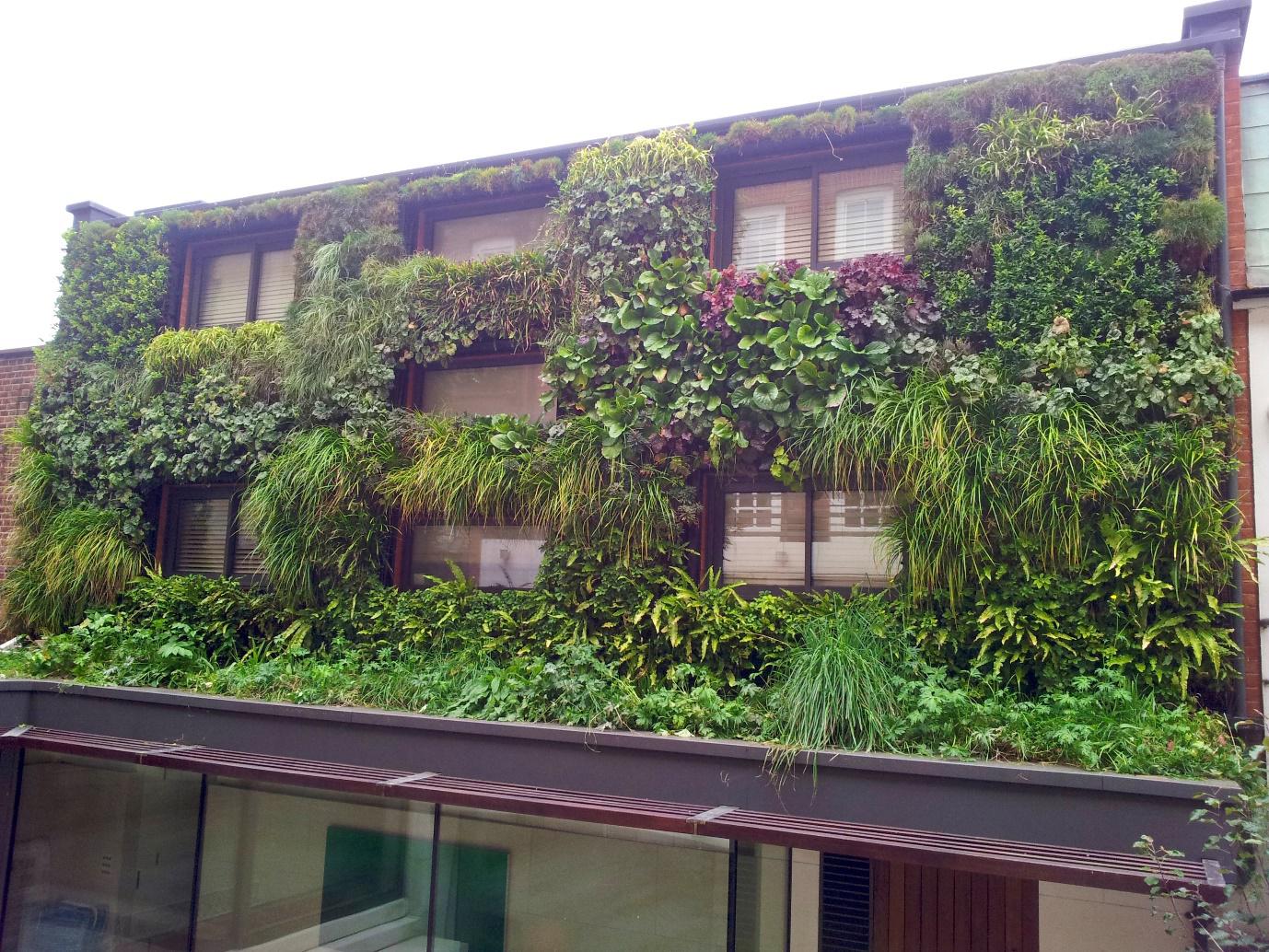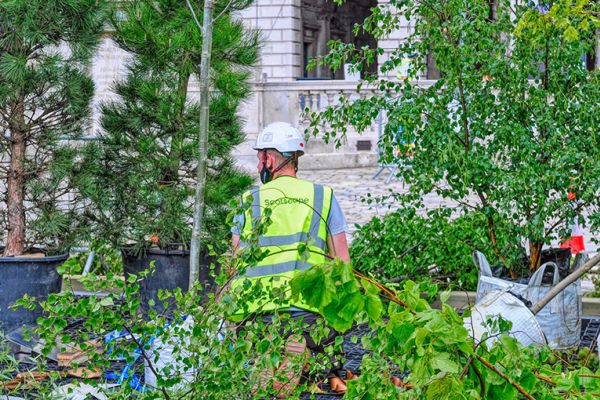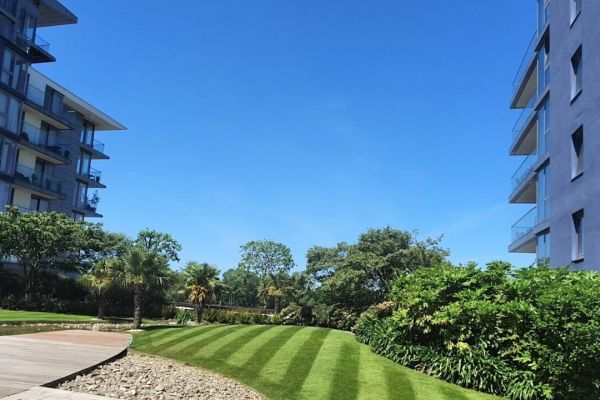Living Walls
For healthier happier cities
Living Walls
Living Walls & Green Walls designed, installed and maintained by Scotscape for improved biodiversity, air quality & to mitigate the urban heat island.
About Our Living Walls
What is a Living Wall?
Living walls are an innovative way to introduce sustainable planting to vertical surfaces.
Our patented Fytotextile living wall system was introduced to the UK market in 2010 and has been designed to support long term plant health. It is lightweight, flexible and can sustain a wide palette of plants including mature shrubs and trees.
Living Walls Key Benefits
Urban biodiversity

Introducing sustainable biodiversity to our cities is our challenge.
It all starts with the plants. Without them, biodiversity would not be possible.
We encourage the use of native plant species and those on the Royal Horticultural Society pollinator list. Living walls give us a wonderful opportunity to help Nature back into our towns and cities as horizontal space is at such a premium. Vertical surfaces are underused.
We encourage the use of insect and bird boxes on our schemes. When they are not providing homes for our fauna, they give an important visual message about biodiversity.
Air Quality
There is endless data available demonstrating the ability of plants to trap and absorb pollution. This, of course, is what plants have been doing for millennia.
The nature of city landscape can create ‘the street canyon effect’ which traps pollution at street level. Living walls can increase the deposition rate of harmful particulate matter by as much as 40% of nitrogen dioxide and 60% when planted correctly.

The most efficient way to combat the street canyon effect is with plant topography. As our system supports mature planting, we are able to trap increased amounts of particulates. Our experts will select the best plants to improve the health and well-being of city residents.
With the range of plants our system can support, we often refer to our schemes as Vertical Gardens.

Green aesthetics and WOW! factor
We have been installing Living Walls since 2008 but they have not lost the ability to create the WOW factor unrivalled by other interior or exterior finishes. A useful tool in attracting footfall to our high streets.

Before

After
Our vertical gardens help companies communicate green credentials to their customers.
Championed by councils, business improvement districts, private landlords and well-known retailers, they demonstrate a commitment to achieving sustainability targets and corporate social responsibility.
It is WOW with substance!
The urban heat island effect
High urban temperatures are caused by the increased capacity of the urban land surface (eg. roads, buildings, pavements) to absorb and trap heat. This causes our city temperatures to be up to 10c higher than rural areas, resulting in the Urban Heat Island effect.
Adding living walls and green roofs to urban structures mimics the conditions presented in rural surroundings. Evapo-transpiration from plants mitigates the urban heat island effect and makes cities more comfortable places to live in the summer months by reducing temperatures.
‘Green facades effectively remove 50% of solar radiation. In summer vegetated roofs can be up to 50c cooler than conventional roofs.’ - Arup Green Buildings

Living walls provide great insulation
Living walls provide great insulation - keeping buildings cool in the summer and warmer in the winter – creating energy efficiencies.
We first researched this benefit in 2011 with Sheffield University,

Our most recent research was in 2021 with Plymouth University which found that living walls can reduce heat loss from buildings by over 30%.
Acoustic benefit
Living wall structures can reduce noise levels. Plants are regularly used to reduce noise on motorways and within urban environments.
Living walls reduce noise levels by reflecting, refracting as well as absorbing acoustic energy.
‘Green facades can absorb traffic noise reducing sound levels by up to 10 decibels’ – Living Wall Hoxton Hotel Holborn
Mental Health

Studies show that that being close to plants helps reduce stress in working environments, leading to happier healthier staff and improved staff retention.
We are, of course, hard wired to Nature so introducing sustainable planting will attract biodiversity and make our cities healthier and happier places to live work and play.
Testimonials
-
"Many thanks for the presentation Niall, inspirational and informative in equal measure! Living walls are a really exciting and progressive architectural development, I hope that they will become more widely used in the future."
Stuart MeadowsArchitect, HNW Architects -
"We use Scotscape across all of our developments to do our planting and maintenance at our sales & marketing suites as well as our show home garden designs. Scotscape are creative in their design and knowledgeable. They are a great team to work with, always deliver on time and to a high standard."
Hayley JenningsSenior Marketing Manager, Berkeley Homes Eastern Counties Ltd -
"We found them to be very professional throughout, from initial engagement up to completion. The nature of our project & our Client’s requirements necessitates the need for our supply chain partners to be reactive & flexible throughout and Darren & the whole team, were nothing but!"
Sean KennyProject Director, Bouygues E&S Contracting Ltd
View Other Products & Services
Useful Links
© Copyright 2024 Scotscape Group Limited. All rights reserverd. Cookie Settings





